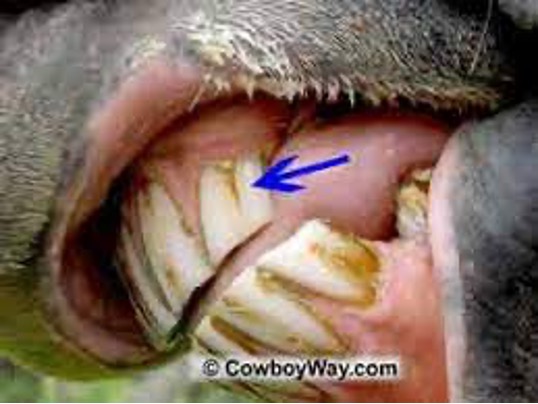Equine Nutrition and Dentistry
1/32
Earn XP
Description and Tags
Flashcards about Equine Nutrition, Dentition, and Common Clinical Problems Related to Diet
Name | Mastery | Learn | Test | Matching | Spaced |
|---|
No study sessions yet.
33 Terms
Roughage/Forage
Cut and cured feed containing more than 18% crude fiber when dry and are low in energy (ex. hay, pasture)
Pasture Plants
Roughages that have not been cut, eaten directly from plant in the pasture (ex. fescue, Bermuda grass, rye grass)
Concentrates
Grains, protein source, vitamin/mineral supplements.
Hind Gut Fermentation
Fermentation occurs after food has passed through the stomach.
Hind Gut Fermentation process
Anaerobic bacteria in the cecum breakdown fiber (cellulose from plants) into glucose and then into 3 volatile fatty acids: acetic acid, butyric acid, and propionic acid.
Herbivore Fermentation
Allows low-quality feeds (grasses, forages, plants) to be utilized to their full capacity - used for both amino acids and glucose.
Gallbladder Absence in Horses
Bile acids are excreted continuously in the liver because the horse cannot store bile.
Horses can use up to 10-15% fat in their diet
FEEDING CALCULATIONS FOR HORSES
Adult (maintenance) requires 1.5 % to 2 % of body weight of forage dry matter per day
A 1,000 # horse requires 1.5 % dry matter(DM) forage daily
1,000 X 1.5% = 15 # of forage per day
1 “flake” of hay weighs 5 # (DM basis)
15 ÷ 5 = 3 flakes of hay per day
WATER
Vital to all body systems (Approximately 70% of body weight of horse is water)
Horses fed hay will drink 40-50 L (10.5-13 gallons) of water daily
Creep Feed
High energy, easily digestible concentrate (grain, sweet feed) placed where foal has access, but mare does not.
A BCS of 5/9 is ideal

Epiphysitis
A condition in growing horses characterized by inflammation of the growth plates, often related to excessive nutrition or rapid growth.
Osteochondrosis dissecans
A developmental condition in young horses where cartilage fails to ossify properly, leading to joint pain and potential lameness.
Laminitis
Inflammation of the sensitive lamina within the hoof (between hoof wall and distal phalanx) causing downward rotation of distal phalanx.

EXERTIONAL RHABDOMYOLYSIS (“TYING UP”)
A condition in which muscle cells are damaged due to excessive exercise or exertion, leading to stiffness, pain, and dark-colored urine. It commonly occurs in horses after intense exercise.
CANTHARIDIN TOXICITY/ BLISTER BEETLE TOXICITY
A condition caused by the ingestion of cantharidin, a toxic substance found in blister beetles, leading to severe gastrointestinal distress, colic, and urinary damage in horses.
MYCOTOXICOSIS/AFLATOXICOSIS
“Moldy feed” disease
A condition caused by the ingestion of mycotoxins produced by fungi, leading to various health issues including liver damage and immunosuppression in horses.
Choke
When partially digested food gets wadded up and stuck in esophagus
Colic
Abdominal pain in horses, often caused by gastrointestinal disturbances.
Signs of Colic
Standing and lying down, rolling, kicking at the abdomen, pawing, looking at the abdomen, grunting, sweating, distention of the abdomen, straining to urinate or defecate, decreased bowel movement, rapid breathing, flared nostrils, abnormal behavior, and lack of appetite
Colic Treatment
Administration of mineral oil, pain medication, hand walking, and IV fluids (severe cases surgery) for abdominal pain in horses.
Hyperkalemic Periodic Paralysis (HYPP)
Genetic and nutritional problem with potassium intake into the cell causing periodic generalized muscle weakness and interference of heart muscle conduction.
Full mouth
Age 5, all permanent teeth are erupted
Galvayne’s groove
Groove at the gum margin on upper corner incisor.
Dental Floating
Filing or rasping the sharp points of the teeth.
Caps
Retained deciduous premolars; often loose and painful to the young horse, may be reluctant to eat
Wolf Teeth
First premolar; removal is usually due to interference with bit.
Equine Metabolic Syndrome
Signalment- 5-15 years, obese
Cause: metabolic dysfunction + insulin resistance
Clinical signs: obesity, laminitis
Diagnosis: insulin/glucose levels
Treatment:management, diet
Equine Cushing Syndrome (Pituitary Pars Intermedia Dysfunction – PPID)
Seen in older obese horses
Causative agent: Hyperadrenocorticism and cortisol excess (pituitary dysfunction)
Clinical signs: PU/PD, long, thick, curly hair coats, failure to shed in the spring, dull hair coats, sway back and pot belly, laminitis, fat deposition in the supraorbital fossa, weight loss, increased appetite, depression, and increased sweating,
Diagnosis: ACTH, cortisol, insulin, and glucose
Treatment: Pergolide mesylate
GI ULCERATION
Condition where sores develop in the gastrointestinal tract, commonly seen in stressed or high-performance horses. Symptoms include colic, weight loss, and decreased appetite.
Galvayne’s groove
Groove at the gum margin on upper corner incisor
•9 to 10 years: Appears at gum margin
•15 years: Halfway down surface
•20 years: Extends entire length
•25 years: Disappears from upper half of tooth
•30 years: Disappears totally

DENTAL ANATOMY
Buccal surface of maxillary premolars/molars and lingual surface of mandibular premolars/molars are unopposed and become sharp
Filing or rasping the sharp points of the teeth is known as
floating the teeth.